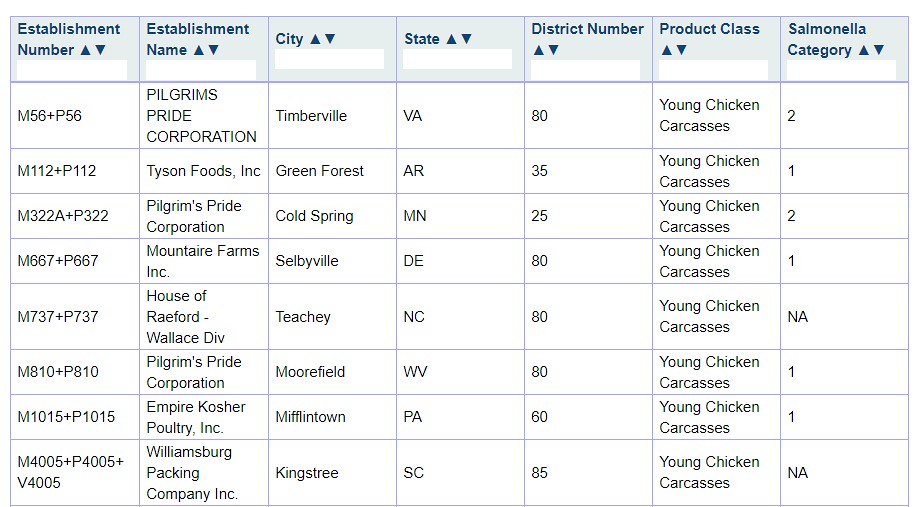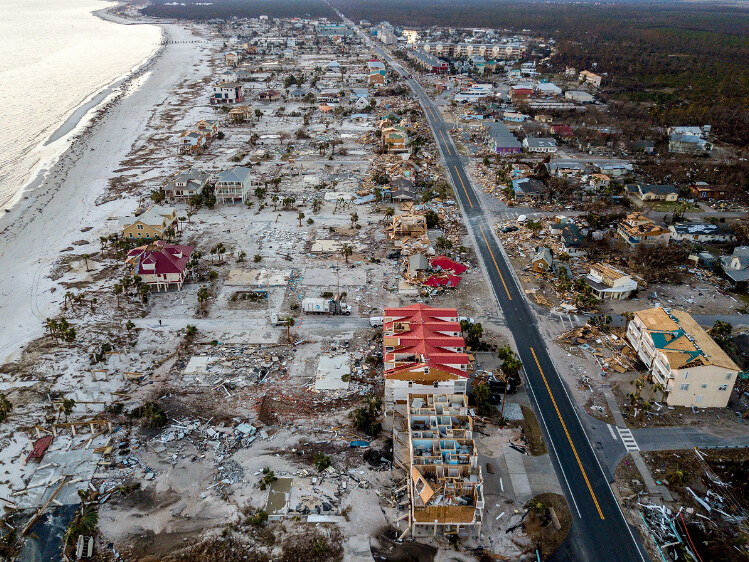Source: Beatrice News Channel
Amid the growing concern of the Romaine Lettuce contaminated with E.Coli over the Thanksgiving weekend, there has been a heightened discussion surrounding bacteria -- Salmonella in general. For up to date information on the Romaine Lettuce contamination, please visit the Center for Disease Control and Prevention (CDC) web page for the outbreak. This discussion is not new. In fact, behind the scenes, the Food Safety Inspection Service conducted inspections (audits) and found surprising results (not good) through the last year from October 2017 thru til October 2018. Below are the results and grades for the corporations at controlling Salmonella contamination in their products.
Corporations are self-regulated?
As I wrote in a previous blog post, the Food Safety Inspection Service does not inspect each outgoing package of poultry/meat which is sold in the United States. Instead, corporations are subject to stringent documentation processes along with frequent visits to sites by regulators to audit safety of work flow and poultry/meat processing. Which leaves the responsibility to the consumer to ultimately handle the poultry/meat safely (removing bacteria) before serving the final dish to family and friends.
After Thanksgiving weekend, writers at Politico Agriculture followed up on the news of the Romaine lettuce contamination along with potential problems with certain poultry/meat products which are popular around the holidays:
GOOD NEWS/BAD NEWS ON FOOD SAFETY: After getting everyone's attention pre-Thanksgiving, the FDA thinks it has traced the E. coli outbreak in romaine lettuce to growing regions in northern and central California, Pro Ag's Helena Bottemiller Evich and Sarah Zimmerman report. To help better assess future problems, leafy green distributors have now voluntarily agreed to identify where and when their lettuce was grown and harvested (effective immediately).Now for the bad news: The day after Thanksgiving, when few were paying attention, USDA's Food Safety and Inspection Service released data showing that dozens of poultry plants have failed Salmonella performance standards.FSIS reviewed dozens of slaughterhouses from October 2017 through October 2018, after reports of major salmonella outbreaks in chicken and turkey that sickened hundreds around the country. (Each plant is given a category rating from 1 to 3, with "category 3" signifying the company failed performance standards.)— Four Jennie-O plants were found to have high levels of salmonella. That includes the plant in Barron, Wis., that issued a voluntary recall of around 150,000 pounds of ground turkey after FSIS determined the company was one of many brands likely connected to an outbreak that sickened at least 164 people over the past year.— Jennie-O said it has created a "salmonella task force," according to a company statement shared with MA, to "better understand salmonella, and more importantly, what actions we can take to prevent it."
— Nearly three-fourths of slaughterhouses of Perdue Farms, one of the country's top poultry producers, failed to meet performance standards for chicken parts. A Perdue spokesperson said the rankings "don't necessarily reflect current plant salmonella levels."Thomas Gremillion, director of the Consumer Federation of America's Food Policy Institute, told MA the number of failed performance standards was due in part to "weak incentives under federal rules for poultry companies to attend to the bacteria."— Most major poultry companies have at least one "category 3" processing plant, with more than 15.4 percent of samples testing positive for salmonella, Gremillion noted.
Wow. Bad grades were found among poultry plants - which is concerning from a health and safety standpoint. After reading the above news, the 'rating system' is probably sitting heavily on your mind (as it was for me last night). The United States Department of Agriculture posted results of the survey with a glossary of terms shown below:
Source: USDA - FSIS
Note that the USDA posted the glossary at the end of the web page which piqued my curiosity. Why not show the rating categories in the beginning? Before the data rather than after. Regardless, the results are concerning to say the least. In order to interpret the results effectively as a reader/consumer, the following 'rules' which dictate the 'category' are shown below:
Source: USDA-FSIS
After posting the image of the categories for the inspectors to place grades into, I realized that the text is too small. Below are the categories restated:
Category DefinitionsCategory 1: Establishments that have achieved 50 percent or less of the maximum allowable percent positive during the most recent completed 52-week moving window.Category 2: Establishments that meet the maximum allowable percent positive but have results greater than 50 percent of the maximum allowable percent positive during the most recent completed 52-week moving window.Category 3: Establishments that have exceeded the maximum allowable percent positive during the most recent completed 52-week moving window.NA: FSIS did not collect or analyze the minimum number of samples to categorize the establishment and the establishment has not exceeded the maximum number of positives allowed under the standard.
The inspectors additionally broke down the inspections into specific parts of the chicken and different chickens as shown below:
Source: USDA-FSIS
Again, the image is rather small (the text in the image), therefore to view the results, click on the hyperlinked text "USDA-FSIS" and scroll down to the bottom of the web page (which is long). The glossary and breakdown of results are worth viewing. The overall message of the results is that the inspection uncovered the fact that major outbreaks of salmonella have occurred frequently and are of great concern. I do not pretend to have the solution. Although, I would offer that less regulation is not the answer. More inspections and regulations are needed.
Conclusion...
According to a report from the news website 'Today' titled "FDA update on romaine lettuce: Safe to eat as long as lettuce is not from central CA" Romaine lettuce is good except from Central (California). Still, I would suggest exercising great caution while handling lettuce before preparing it for a meal. Recent research out of University of California at Riverside has unveiled the fact that "pre-rinsed" lettuce is not without bacteria. Simply because of the shape of the pore inside the lettuce leaf, the thought is that bleach does not effectively reach into the pocket (pore) and appropriately kill the bacteria at 'regulated concentrations' of bleach used by corporations. Professor Sharon Walker leads the research as shown in the video below:
As Professor Walker points out that there is very little scientific evidence behind the regulation which is involved in cleaning lettuce. The work here will have impact in other areas of food research. The poultry industry will undoubtedly be included in the new research. According to the results shown above, there is plenty of room for improvement in developing new ways to remove/control the spread of bacteria (i.e. Salmonella) in the food industry.
Until those new innovative ways are translated into policy and regulations, please take appropriate steps to avoid the unwanted spread of bacteria among consumer products both inside and outside of your household.
Related Blog Posts:
One Unknown Fact Which Should Cause Consumers To Be Careful About Handling Meat Before Cooking!
Natural Disasters Have Long Term Effects Which Are Quickly Forgotten?
What is the next big step in Mental Health Research?
A Forecaster Predicts That Hurricane Florence Will Drop Enough Rain To Fill 18,400 Mercedes-Benz Superdomes
Hurricane Harvey Drops Enough Rain On Houston To Fill 560 Dallas Cowboy Stadiums
How Much Water Is Contained In All Oceans Around The Globe?
Storm Raises Water Level In Lake Cachuma By 31 feet, How Much Water Is That?
How To Make Sense Of Water Flowing At 100,000 Cubic Feet Per Second
Can 11 Trillion Gallons Of Water Fill 14,000 Dallas Cowboys Stadiums?
How Much Rain Did The East Coast Receive From Hurricane Matthew?
How Much Rain Did Haiti Really Receive?
How Big Was The "Water Bomb" Of Rainfall In Macedonia?
How Much Rain Did Elliot City (Maryland) Really Receive?
If The Mosul Dam Breaks, The City Of Mosul Would Be Under 65 Feet Of Water?
What is the volume of water in a few inches of rain?
Volume of Waste in the Mine Spill (in Brazil) Equivalent to 78 Deepwater Horizon Oil Spills













